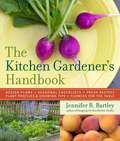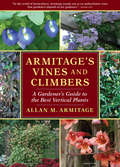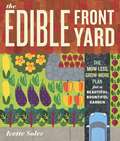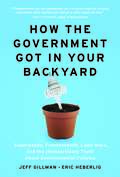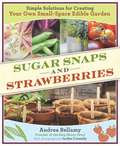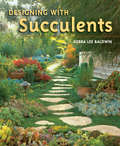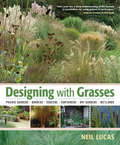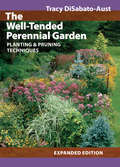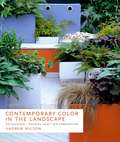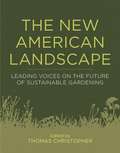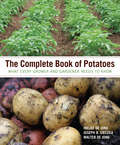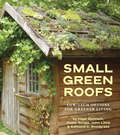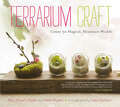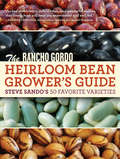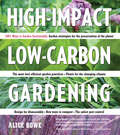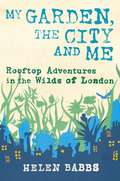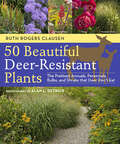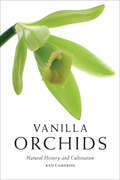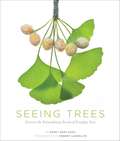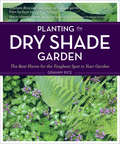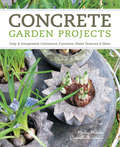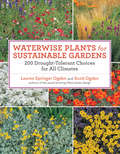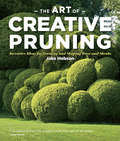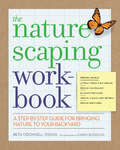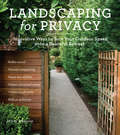- Table View
- List View
The Kitchen Gardener's Handbook
by Jennifer R. Bartley“A mouthwatering picture book.” —Toronto Tasting Notes No longer content with separating the plants they grow to eat and the plants they grow for beauty, gardeners are discovering the pleasures of incorporating both edibles and ornamentals into their home landscapes. The Kitchen Gardener's Handbook makes it easy. Whether she's sharing tips on planting radishes in spring, harvesting tomatoes in summer, or pruning perennials in winter, Bartley's friendly advice gives gardeners the tools they need to build and maintain a kitchen garden. Readers will learn how to plant, grow, and harvest the best vegetables, fruits, greens, and herbs for every season. They'll also find seasonal recipes that celebrate the best of the harvest, monthly garden chores, eight sample garden designs, and information on using cut flowers for decoration. The Kitchen Gardener's Handbook is a guide for gardeners who want it all—the freshness of fruits and vegetables and the beauty and simplicity of hand-picked bouquets.
Armitage's Vines and Climbers: A Gardener's Guide to the Best Vertical Plants
by Allan M. Armitage“Climbing plants are hugely underrated—this book with its lively expression of deep knowledge should encourage everyone to grow more of them.” —Noël Kingsbury Climbing plants constitute a huge, and largely untapped, resource for today’s gardeners. Because their habit of growth is primarily vertical, they can be used for utilitarian as well as ornamental purposes like providing privacy, or screening eyesores. In this comprehensive reference, renowned horticulturist Allan Armitage selects and profiles the most useful and attractive climbing plants for a wide range of sites and conditions, from well-known favourites like clematis, morning glories, and wisteria to more unusual plants like Dutchman’s pipe, passion flowers, and the tropical mandevillas. Each profile includes a general description (enlivened by Armitage’s trademark wry humour) along with the plant’s hardiness, plant family, best method of propagation, method of climbing, and etymology of botanical and common names.“Climbing plants are hugely underrated—this book with its lively expression of deep knowledge should encourage everyone to grow more of them.” —Noël Kingsbury
The Edible Front Yard: The Mow-Less, Grow-More Plan for a Beautiful, Bountiful Garden
by Ivette Soler“Front lawns, beware: The Germinatrix has you in her crosshairs! Ivette Soler is a welcome voice urging us to mow less and grow some food—in her uniquely fun, infectious yet informative way.” —Garden RantPeople everywhere are turning patches of soil into bountiful vegetable gardens, and each spring a new crop of beginners pick up trowels and plant seeds for the first time. They're planting tomatoes in raised beds, runner beans in small plots, and strawberries in containers. But there is one place that has, until now, been woefully neglected—the front yard. And there's good reason. The typical veggie garden, with its raised beds and plots, is not the most attractive type of garden, and favorite edible plants like tomatoes and cucumbers have a tendency to look a scraggily, even in their prime. But The Edible Front Yard isn't about the typical veggie garden, and author Ivette Soler is passionate about putting edibles up front and creating edible gardens with curb appeal. Soler offers step-by-step instructions for converting all or part of a lawn into an edible paradise; specific guidelines for selecting and planting the most attractive edible plants; and design advice and plans for the best placement and for combining edibles with ornamentals in pleasing ways. Inspiring and accessible, The Edible Front Yard is a one-stop resource for a front-and-center edible garden that is both beautiful and bountiful year-round.
How the Government Got in Your Backyard: Superweeds, Frankenfoods, Lawn Wars, and the (Nonpartisan) Truth About Environmental Policies
by Jeff Gillman Eric HeberligBiotechnology—the future or a genetic time bomb? Renewable fuels—the key to cleaner air or just corporate welfare? Greenhouse gasses—baking the earth to death or just a needless worry? Plant patents—improving gardens and farms or just profiteering? When you stop to think about it, the government has its hand in every important environmental issue. And with the left and the right raucously disagreeing about whether the government’s policies are for good or for evil, it’s impossible for a concerned citizen to know what to think.How the Government Got in Your Backyard distills the science, the politics, and the unbiased, nonpartisan truth behind hot-button environmental issues from pesticides to global warming. By clearly representing what the left says, what the right says, what the science is, and what the facts are, Gillman and Heberlig don’t set out to provide the answer—they light the path so concerned citizens can uncover their own true and informed opinion. In this season of political discontent, the unbiased truth about environmental policies—free of political agendas—is as refreshing as it is fascinating.How the Government Got in Your Backyard is not for Republicans or Democrats, liberals or conservatives. It’s for anyone who is ready to get to the bottom line.
Sugar Snaps and Strawberries: Simple Solutions for Creating Your Own Small-Space Edible Garden
by Andrea Bellamy Jackie ConnellyImagine savoring fresh-picked strawberries on a weekend morning, plucking plump figs from your mini-orchard to quarter and serve at a farm-to-table meal with friends, or harvesting and sautéing the edible stalks of garlic bulbs. If the size of your space is bringing you back to reality, here's the best part: you don't need a big backyard to grow your own food. In fact, you don't need a yard at all. Andrea Bellamy, founder of the acclaimed blog Heavy Petal, gives you the dirt on growing gorgeous organic food with very little square footage. Simple, straightforward, design and growing advice can help you transform just a snippet of space into a stylish and edible oasis. Bellamy goes beyond the surface and shows you how to create and maintain healthy soil, decide what and when to plant, sow seeds and harvest, and most importantly, enjoy the process. So go ahead, picture that tiny nook, corner, strip, porch, alley, balcony, or postage-stamp-sized yard overflowing with fingerling potatoes, fragrant herbs, sugar snap peas, French breakfast radishes, and scarlet runner beans. Armed with luscious photography, encouraging tips, and sophisticated designs, you're sure to be inspired to join the grow-your-own revolution.
Designing with Succulents: 10th Anniversary Edition
by Debra Lee BaldwinLavishly illustrated with over 300 photographs, Designing with Succulents gives design and cultivation basics for paths, borders, slopes, and containers; hundreds of succulent plant recommendations; and descriptions of 90 easy-care, drought-tolerant companion plants. Beginners and experienced designers, landscapers, and collectors alike will find what they need to visualize, create, and nurture the three-dimensional work of art that is the succulent garden.
Designing with Grasses
by Neil LucasDesigning with Grasses shows gardeners not just what grasses are available, but how to design with grasses in different settings, including meadows, lawns, green roofs, and more. Design ideas are supported by carefully devised maintenance techniques, design checklists that make designing achievable by gardeners of all ability levels, and lists of grasses best for a variety of situations, including low-maintenance, drought-tolerant alternatives to the traditional lawn grasses and grasses suitable for green roofs and erosion control. An encyclopedic A to Z of grasses includes profiles with information on growth and care.
The Well-Tended Perennial Garden: Planting & Pruning Techniques
by Tracy DiSabato-AustWith more than 180,000 copies sold since its original publication, The Well-Tended Perennial Garden has proven itself to be one of the most useful tools a gardener can have. Now, in this expanded edition, there's even more to learn from and enjoy. This is the first, and still the most thorough, book to detail essential practices of perennial care such as deadheading, pinching, cutting back, thinning, disbudding, and deadleafing, all of which are thoroughly explained and illustrated. More than 200 new color photographs have been added to this revised edition, showing perennials in various border situations and providing images for each of the entries in the A-to-Z encyclopedia of important perennial species. In addition, there is a new 32-page journal section, in which you can enter details, notes, and observations about the requirements and performance of perennials in your own garden. Thousands of readers have commented that The Well-Tended Perennial Garden is one of the most useful and frequently consulted books in their gardening libraries. This new, expanded edition promises to be an even more effective ally in your quest to create a beautiful, healthy, well-maintained perennial garden.
Contemporary Color in the Landscape: Top Designers, Inspiring Ideas, New Combinations
by Andrew WilsonColor is the first and most important design choice a garden designer makes. Over the past decade, landscape architects and garden designers have moved away from the more sedate shades commonly found in traditional gardens and have used plants and hardscape to experiment with explosions of color. From the layered and textural colors of Piet Oudolf to the high contrast colors of Tom Stuart Smith, this increased focus on color is a trademark of today’s leading designers. Contemporary Color in the Landscape explores the whole spectrum of color: how we perceive and respond to color, how to design with color, how to manipulate contrast and create intensity with saturation, how to maximize impact by minimizing color, how to find your own personal color combinations, and how color is viewed in nature. In gorgeous, color-drenched photos Andrew Wilson showcases the work of leading garden designers as inspiring examples of the way color is used. Innovative gardens from all over the world help the reader visualize the core color lessons throughout the book. Supported by more than 300 stunning photographs, Contemporary Color in the Landscape integrates cutting-edge designers, their landscapes, color theory, new design ideas, and gorgeous photography into one inspirational, instructional, and must-have guide for design professionals.
The New American Landscape: Leading Voices on the Future of Sustainable Gardening
by Thomas ChristopherGardeners are the front line of defense in our struggle to tackle the problems of global warming, loss of habitat, water shortages, and shrinking biodiversity. In The New American Landscape, author and editor Thomas Christopher brings together the best thinkers on the topic of gardening sustainably, and asks them to describe the future of the sustainable landscape. The discussion unfolds from there, and what results is a collective vision as eloquent as it is diverse.The New American Landscape offers designers a roadmap to a beautiful garden that improves, not degrades the environment. It’s a provocative manifesto about the important role gardens play in creating a more sustainable future that no professional garden designer can afford to miss. John Greenlee and Neil Diboll on the new American meadow gardenRick Darke on balancing natives and exotics in the gardenDoug Tallamy on landscapes that welcome wildlifeEric Toensmeier on the sustainable edible gardenDavid Wolfe on gardening sustainable with a changing climateElaine Ingham on managing soil healthDavid Deardorff and Kathryn Wadsworth on sustainable pest solutionsEd Snodgrass and Linda McIntyre on green roofs in the sustainable residential landscapeThomas Christopher on waterwise gardensToby Hemenway on whole system garden designThe Sustainable Site Initiative on the managing the home landscape as a sustainable site
The Complete Book of Potatoes: What Every Grower and Gardener Needs to Know
by Hielke De Jong Walter De Jong Joseph B. SieczkaThe only comprehensive resource for home gardeners and commercial potato growers, The Complete Book of Potatoes has everything a gardener or commercial potato grower needs to successfully grow the best, disease-resistant potatoes for North American gardens. Includes practical as well as technical information about the potato plant, its origin, conventional and organic production techniques, pest management, and storage practices. The plant profiles include still life photographs of the exterior and interior of the tuber, and a succinct description of each variety’s physical and culinary qualities.
Small Green Roofs: Low-Tech Options for Greener Living
by Nigel Dunnett Dusty Gedge John Little Edmund C. SnodgrassUntil now, the green roof movement has been limited to large-scale, professional endeavors and public buildings. But homeowners everywhere are catching onto the benefits of a green roof—water conservation, energy savings, and storm water management. In Small Green Roofs authors Dunnett, Gedge, Little, and Snodgrass profile ordinary homeowners who scaled green roofs down to the domestic level.Small Green Roofs is the first book to focus on small-scale and domestic green roofs. More than forty profiles of small and domestic-scale projects of all shapes and sizes include green roofs on sheds, garden offices, studios, garages, houses, bicycle sheds, and other small structures, as well as several community projects. For each project, details are given for design, construction, and installation, as well as how-to tips on how the roof was planted and cared for. For readers looking for inspiration when hiring a contractor or taking the adventurous step of building their own, Small Green Roofs provides the knowledge and encouragement to make it possible.
Terrarium Craft: Create 50 Magical, Miniature Worlds
by Kate Baldwin Amy Bryant Aiello Kate BryantA terrarium is nothing less than a miniature world—one that you can create yourself. It might be a tiny rainforest, with lush foliage and bright tropical flowers. Or a desert, with strange succulents planted among colorful stones. Or a Victorian fernery. Or a minimalist composition with a single, perfect plant.Or it might not contain any plants at all. It might be made with crystals, feathers, bones, seashells, bits of wood, porcelain trinkets—anything that catches your fancy and helps create a mood or look. Whatever they contain, terrariums are the ultimate in modern, affordable, easy-care décor.Terrarium Craft features fifty original designs that you can re-create or use as inspiration for your own design. Each entry comes with clear step-by-step directions on how to assemble and care for your terrarium. You’ll also find helpful information about selecting a container, using appropriate materials, choosing the right plants, and maintaining your terrarium. (Hint: It’s easy! In fact, many terrariums are self-sustaining, requiring no maintenance whatsoever!)
The Rancho Gordo Heirloom Bean Grower's Guide: Steve Sando's 50 Favorite Varieties
by Steve SandoSteve Sando founded Rancho Gordo with the simple idea that saving our New World foods is a critical pursuit, and his passion for heirloom beans has made his business a huge success. Sando’s beans are sought after by famous chefs like Thomas Keller (Vallarta is his favorite), and he’s frequently profiled in publications such as Bon Appetit, Saveur, and the New York Times.In The Rancho Gordo Heirloom Bean Grower's Guide, Sando invites the gardener and home cook to share his passion, profiling the fifty best beans to grow, cook, and save. From the silky flavor of Good Mother Stallard to the buttery Runner Cannellinis, the most delicious varieties are presented in these pages along with growing tips, flavor notes, stories of their heritage, and beautiful photographs that showcase the unique beauty of each bean. In reintroducing the best of the New World heirloom beans, Sando has created a sensation, and food-lovers everywhere will relish transforming this humble staple into a celebrated delicacy.
High-Impact, Low-Carbon Gardening: 1001 Ways to Garden Sustainably
by Alice BoweThe environmental benefits of gardens are well-known: trees and plants capture carbon emissions, help to moderate the urban climate, promote health and well being, and help reduce energy consumption. But some garden practices are downright damaging, like using leaf blowers and other power tools, installing impermeable paving, and choosing plants that require excessive water or artificial fertilizers. High-Impact, Low-Carbon Gardening is a one-stop reference for making a garden more green. From simple actions like composting household waste, installing a water barrel, or eliminating pesticides to more long-term investments like choosing permeable, locally sourced paving, and planting the most water-wise plants, there are hundreds of large and small choices home gardeners can make to reduce the environmental impact of designing, planting, and tending a garden. High-Impact, Low-Carbon Gardening goes beyond organics and compost and gives serious gardeners all the information they need to make their garden truly green.
My Garden, the City and Me: Rooftop Adventures in the Wilds of London
by Helen BabbsHelen Babbs is a self-proclaimed city girl who lives on the second floor of a flat in a chaotic corner of London. An urge to find more green in the city and a stronger connection to the natural world leads her to create her first garden, an organic edible garden on her rooftop. This year-long adventure is the story behind My Garden, the City and Me. The journey begins in the dark of winter, where Babbs finds herself at a seed swap on a February morning, seduced more by packaging than by any true understanding of the plants. As the year progresses, Babbs revels in failures, like waking up bleary eyed and stomping on her seed starts, and triumphs like her summer-ending dinner party made with homegrown produce. Along the way she discovers “that I like gardening in my pajamas and that growing something from seed, watching it develop and then eating its fruits is truly joyful. I’ve daydreamed out there and entertained out there. It’s the force behind new friendships that I’ve forged. The garden has opened my eyes to a whole new side of London and urban living.”My Garden, the City and Me is a lyrical narrative about a twenty-something in search for a bit of wild in her city. The journey is charming, honest, and steeped in the lore of London, a city equally known for its gardens and its grit. In the end Babbs has achieved a new perspective on what it means to live green in the city she loves.
50 Beautiful Deer-Resistant Plants: The Prettiest Annuals, Perennials, Bulbs, and Shrubs that Deer Don't Eat
by Alan L. Detrick Ruth Rogers ClausenKeeping your beautiful garden safe from deer is as simple as choosing the right plants. Are deer destroying your garden? There is a solution, and it doesn’t involve fencing, barriers, or chemicals. In 50 Beautiful Deer-Resistant Plants perennial expert Ruth Rogers Clausen highlights the best, most versatile plants that deer simply don’t eat. The plant choices include annuals and perennials, shrubs, ferns, bulbs, grasses, and herbs; for each Clausen shares helpful growing and design tips. This practical, authoritative, full-color guide is a must-have solution to a must-stop problem.
Vanilla Orchids: Natural History and Cultivation
by Ken CameronWith more than 30,000 known species, orchids represent the largest family of plants. But only one genus has agricultural value—the Vanilla orchid. Leading orchid expert Ken Cameron covers the natural history of the world’s most popular flavor and fragrance and provides an introduction to the pollination, biology, structure, evolution, and diversity of Vanilla and related orchids. Vanilla Orchids also features methods for bean harvest, curing, and processing for enthusiasts who want to try it at home.
Seeing Trees: Discover the Extraordinary Secrets of Everyday Trees (Seeing Series)
by Nancy Ross Hugo Robert LlewellynHave you ever looked at a tree? That may sound like a silly question, but there is so much more to notice about a tree than first meets the eye. Seeing Trees celebrates seldom seen but easily observable tree traits and invites you to watch trees with the same care and sensitivity that birdwatchers watch birds. Many people, for example, are surprised to learn that oaks and maples have flowers, much less flowers that are astonishingly beautiful when viewed up close. Focusing on widely grown trees, this captivating book describes the rewards of careful and regular tree viewing, outlines strategies for improving your observations, and describes some of the most visually interesting tree structures, including leaves, flowers, buds, leaf scars, twigs, and bark. In-depth profiles of ten familiar species—including such beloved trees as white oak, southern magnolia, white pine, and tulip poplar—show you how to recognize and understand many of their most compelling (but usually overlooked) physical features.
Planting the Dry Shade Garden: The Best Plants for the Toughest Spot in Your Garden
by Graham RiceIn this book you'll learn how to prune selectively to admit more light and how to amend soil to increase its moisture retention. You'll also learn about more than 130 plants that accept reduced light and moisture levels-long-blooming woodland gems like epimediums and hellebores, and even lush foliage plants like evergreen ferns and hardy gingers, shrubs, climbers, perennials, ground covers, bulbs, annuals, and perennials- there is an entire palette to help you transform challenging spaces into rich, rewarding gardens.
Concrete Garden Projects: Easy & Inexpensive Containers, Furniture, Water Features & More
by Camilla Arvidsson Malin NilssonFor gardeners and backyard do-it-yourselfers, concrete is a revelation. It's durable, weatherproof, impossible to steal, and it provides much-needed insulation for outdoor plants. Concrete weathers beautifully, softening around the edges, developing moss, and becoming more picturesque with age.Concrete Garden Projects takes advantage of concrete's numerous assets, showcasing an inspiring array of creative options. The step-by-step instructions for dozens of easy, do-it-yourself décor ideas include containers of all shapes and sizes, elegant benches and stools, miniature ponds and birdbaths, stepping stones, a barbecue, and a fire pit. The authors use a variety of molds easily found or made, household items like bowls and baking pans, and simple wooden frames and boxes. At pennies per pound, and so simple to use—just mix with water and pour—concrete is the key to hand-crafted backyard décor.
Waterwise Plants for Sustainable Gardens: 200 Drought-Tolerant Choices for all Climates
by Scott Ogden Lauren Springer Ogden“I can't imagine a designer or avid gardener who wouldn't want this on their bookshelf.” —Garden Design OnlineWaterwise Plants for Sustainable Gardens is a practical guide to the best 200 plants guaranteed to thrive in low-water gardens. Plant entries provide the common and botanical name, the regions where the plant is best adapted, growth and care information, and notes on pests and disease. This practical and inspiring guide includes a variety of plants, from trees to succulents, perennials to bulbs, all selected for their wide adaptability and ornamental value. Companion plants, creative design ideas, and full color photography make this guide a must-have resource for any sustainable gardener.
The Art of Creative Pruning: Inventive Ideas for Training and Shaping Trees and Shrubs
by Jake HobsonNothing brings a touch of artistry to the garden like ornamental pruning, and a series of deliberate cuts can create landscapes and evoke faraway places. All that's needed to recreate the effect in the garden are a sharp pair of pruners, some imagination, and the instruction found in The Art of Creative Pruning. Drawing on both eastern and western styles, author Jake Hobson moves beyond the traditional lollipops and animals and teaches a wholly new approach to ornamental pruning that appeals to modern sensibilities. Picture boxwoods trimmed into whimsical Russian nesting dolls, hedges inscribed with words, and a tree snipped to resemble the toppling tiers of a wedding cake. These are just a few of the unusual ideas featured in the beautifully photographed pages. All the practical considerations are here as well, including pruning to improve a view, remedial pruning to fix problems, and pruning fruit trees to increase yield.
The Naturescaping Workbook: A Step-by-Step Guide for Bringing Nature to Your Backyard
by Beth O'Donnell Young Karen BussoliniMuch of modern garden design is about controlling nature to achieve a desired effect. But for the eco-conscious homeowner, the best garden designer is Mother Nature, and following her lead can result in a beautiful low-maintenance landscape that requires fewer resources, attracts natural wildlife, and saves time and money. In The Naturescaping Workbook, author Beth O'Donnell Young sets forth an easy-to-follow, do-it-yourself plan for gardeners of all skill levels. Her step-by-step approach teaches gardeners to understand their own natural habitat and to nurture the native eco-systems that exist in their yard. And the payoff is huge. By simply becoming aware of the natural wonders in the backyard, anyone can gain a more beautiful garden and take a big step toward bringing nature home.
Landscaping for Privacy: Innovative Ways to Turn Your Outdoor Space into a Peaceful Retreat
by Marty WingateThe area around your home is your haven, your sanctuary, your refuge from the noise and irritation of traffic, eyesores, and nosy neighbors. Or at least it could be if there was some sort of barrier between your front yard and the sidewalk, or if you didn't have to stare at the back of the neighbors' garage when you want to relax on your patio. Landscaping for Privacy brims with creative ideas for minimizing or even eliminating the nuisances that intrude on your personal outdoor space. Scores of real-world examples show you how to keep the outside world at bay by strategically placing buffers (such as berms or groups of small trees), barriers (such as fences), and screens (arbors or hedges, for example) around your property. And the helpful plant lists tell you precisely which varieties to choose in order to enhance your sense of seclusion. If you've ever felt frustrated by the lack of privacy whenever you step outside your home, this inspiring book will steer you toward an achievable solution.
